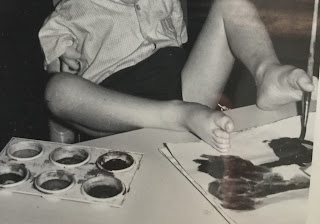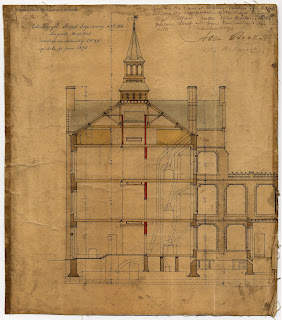Following my time as an intern at Lothian Health Services
Archive earlier this year (for more info see here: https://lhsa.blogspot.com/2019/01/welcome-to-our-new-intern-emma.html,
https://lhsa.blogspot.com/2019/03/intern-emma-discusses-19th-century.html)
I’ve been lucky enough to come back and volunteer for a short time before
starting the MSc in Information Management and Preservation at the University
of Glasgow later in September. I’ve been delving into the range of hospital
magazines produced across different locations in Lothian and have been struck
by both the diversity and high quality of the content in all those I’ve read,
whether produced by staff or collaboratively with patients.
Bruntsfield
Hospital Magazine
The Bruntsfield Hospital magazine was produced by and for
staff and the archive holds copies dating from 1970 to 1985. Topics covered
regularly included hospital news, updates on staff arrivals and departures,
personal news and articles on areas of professional interest such as
physiotherapy at the Commonwealth Games. There is also less work related and
more light hearted material such as recipes, hobbies, jokes, poetry and sly
(anonymous) comments on salaries and conditions in the nurses’ accommodation.
 |
| LHB8/16/3 – Bruntsfield Hospital Magazine - June 1971 |
The magazine also carries detailed historical pieces such as a lengthy article about Sophia Jex-Blake, whose former home became the site of the hospital in 1899 and has of course recently been the subject of renewed media interest and coverage following the posthumous awarding of honorary medical degrees to the Edinburgh Seven.
 |
| LHB8/16/3 – Bruntsfield Hospital Magazine – June 1971 |
Other magazines were a collaborative effort between patients
and staff. The Dingleton
Hospital magazine ‘Outlook’ is an example of a collaborative effort between
patients and staff. It was first published in September 1963 and the archive
holds copies spanning the period from that very first issue until 1986.
 |
| GD30/15 – ‘Outlook’ magazine from Dingleton Hospital |
The first Editorial column set the hopes and objectives for
the magazine in the context of a number of changes taking place in the hospital
at the time, both physical and in the approach to patient care.
The editor
wrote: “It is with the idea of enlarging
this brighter, and pleasanter community aspect of Dingleton that this magazine
has been designed….We do not intend to fill this magazine with stuffy and
high-brow technicalities, or to bore the readers with long unlimited surveys on
medical history, but to fill its pages with good honest humour and humanity.”
From the outset the magazine was run by a committee
comprised of patients and staff and early references suggest a lack of
confidence that publication would continue for more than a few months, which
turned out to be quite an underestimate! The content of the magazine was
tailored to residents and staff, but there was early acknowledgement that there
might also be an external audience and so it was made clear that some of the
articles may be controversial or unsuitable for such a readership.
 |
| GD30/15 – ‘Outlook’ magazine Volume 2 Issue 4, April 1964 |
The breadth and diversity of content is notable – factual
articles, historical pieces, travelogues, creative writing including poetry,
jokes and humour, crosswords, ‘how to’ guides and views on current affairs.
Notably, ideas on how to improve the publication in future are also regularly
sought and aired, including pleas for a wider range of contributors, possible
children’s contributions, sub editors for each topic and protected ‘quiet time’
in the reading room for people to prepare their articles. There are also frequent
references to therapeutic approaches and ‘the group’. The note above makes
clear that the magazine is run as a part of the hospital’s programme and the
patient voice comes through loud and clear in every issue.
Whilst it is easy to get caught up in the enthusiasm that
was obviously felt by contributors and the editorial committee, there are also
pieces which act as a stark reminder of the traumatic events that some
residents had endured and difficulties that they continued to deal with,
illustrated in the poem below.
 |
| GD30/15 – ‘Outlook’ magazine |
The predecessor to both of these publications was the Morningside
Mirror produced at the Royal Edinburgh Hospital, then known as the Royal
Edinburgh Asylum. Copies from 1845 to 1974 are held at LHSA and from the
outset, the Mirror was always intended to appeal to a readership beyond the
hospital. It was produced on a printing press on site in Morningside and from
issue 5 in January 1846, the price (threepence) and stockists were noted. From
December 1847 orders and subscriptions were also encouraged and profits from
the sale of the paper were put towards the
reading room that had been
established.
 |
| LHB7/13/1 - Morningside Mirror first issue – September 1845 |
The Mirror was published monthly and also displayed a very
wide range of content including long detailed articles that sometimes ran over a
number of issues, including on scientific and political topics.
As an early example of the patient voice being made widely
available and the in the context of the wider ‘moral treatment’ approach that
was developing in the nineteenth century, the Mirror has already been the
subject of some degree of academic interest and study, for example in this
essay available on the website of the Society for the Social History of
Medicine https://sshm.org/from-manacles-to-management-moral-treatment-and-the-morningside-mirror-1845-1855/
 |
| Craigleith Hospital Chronicle – GD1/82/7 – August 1915 |
The Craigleith Hospital Chronicle was
published during World War I, when the then Craigleith Hospital and Poorhouse was
taken over as a military hospital. It was renamed as the Second Scottish
General Hospital and used for the treatment of Forces casualties. The Chronicle
was produced by patients and published monthly at a cost of sixpence. Any profits generated were used to provide
for the sick and wounded at the hospital.
Both the appearance and content of
the publication have a definite ‘wartime’ feel. Articles and advertisements are
very much geared towards medical and military audiences, with articles and
poems entitled ‘Notes on the Army’, ‘Gallipoli – in Memoriam’ and ‘A Nurse’s
Notes from Serbia'.
The advertisement below is for an
‘Invalid Suit’, specifically designed for the comfort of wounded servicemen but
is marketed to nursing staff as something they might want to invest in, to
address the specific needs of their patients.
 |
| GD1/82/1 – Volume One, Number Two – January 1915 |
 |
| LHB39/8/11 – ‘Fortune’ magazine - November 1955 |
East Fortune Hospital was
founded in Drem, East Lothian 1922 as a tuberculosis sanatorium. In 1956 as
tuberculosis patients began to decrease in number, patients with other types of
illnesses began to be admitted. The archive holds two issues of
‘Fortune’ magazine from 1955 and 1957 and interestingly the Editorial column of
the 1957 issue highlights (and welcomes) the considerable drop in patient numbers
whilst noting that a sufficiency of material was still being produced for
inclusion.
What is immediately striking about this magazine is the incredibly
high quality of its production. Using glossy paper with clear photographs and
advertisements for high end local businesses, the magazines were printed externally
by the Hawick Express and have a very professional feel.
The content was
produced by patients and staff and patients and there were also contributions
from notable figures – the Countess of Haddington and Her Grace the Duchess of
Portland wrote the Forewords in 1955 and 1957 respectively and there was also a
Christmas letter to the patients from Leonard Cheshire.
 |
| LHB39/8/11 – Letter from Leonard Cheshire |
 |
LHB1/109A/32 – The Pelican magazine
1956
|
The Pelican is the staff magazine of what is now The Pelican
Nurses’ League - an organisation of nurses who trained at the Royal Infirmary
of Edinburgh. The archive holds copies of the magazine from 1927 to 2008. There
is a fascinating blog by LHSA Archivist Louise from 2017 on The Pelican (http://lhsa.blogspot.com/2017/05/a-most-peculiar-bird.html)
so I won’t say too much about it here, however it illustrates the breadth in
types and longevity of the publications that were produced across the various
hospitals in Lothian.
It’s been so interesting looking through the different
hospital magazines that are held here at LHSA. For me, the most immediately
appealing have been those which are produced primarily by and for patients, as
they offer some degree of insight into the patient experience although the
reader cannot know the full degree of any editing or censorship that took place
prior to publication. Regardless, there is no denying that, as the Editor of
Dingleton hospital’s magazine hoped, they are each a good read and all contain
their fair share of “good honest humour
and humanity”.
We would like to say a
huge thank you to Emma for the excellent work she has done here at LHSA in both
her internship and her brief spell as a volunteer. We wish you all the very
best in your studies and we hope to see you again soon!







































